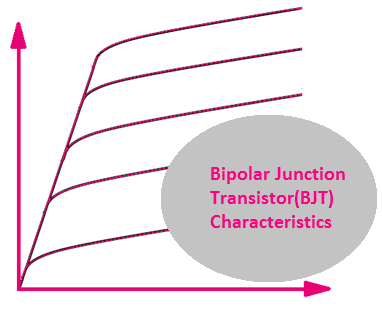Bipolar Junction Transistor(BJT) Characteristics
The common characteristics of BJT are,
At Common Base Configuration,
- Low Input Impedance
- High Output Impedance
- Zero(0) degree phase shift
- High Voltage Gain Low Current Gain
- Low Power Gain
At Common Emitter Configuration,
- Medium Input Impedance
- High Output Impedance
- 180-degree phase shift
- Medium Voltage Gain
- Medium Current Gain
- Very High Power gain
At Common Collector Configuration,
- High Input Impedance
- Low output impedance
- Zero(0) degree phase shift
- Low Voltage Gain
- High Current Gain
- Medium Power gain
General Current-Voltage or IV Characteristics of BJT,
The general IV characteristics of BJT are divided into five parts,
- Cutoff Region
- Active Region
- Quasi Saturation Region
- Hard saturation Region
- Breakdown Region
Cutoff Region
The cutoff region is that in which the BJT provides a very high resistance and it does not conduct any current. The cutoff region happens when there is no voltage in the base terminal or the applied voltage is lower than the threshold voltage of that BJT. We can say it acts as an open circuit.
Active Region
In this region the transistor conducts current. And the increasing or decreasing of the flow of current happens linearly. The collector current Ic increases linearly with the increase of base voltage or base current. In this region, the dynamic resistance offered by the transistor is more and the maximum power dissipation also happens in this region. Sometimes the active region is also called the ohmic region.
Quasi Saturation Region
This region occurs when the BJT operates with a very high-frequency signal. In this region, both junctions are forward-biased. As the transistor does not go into a deep saturation region so the changes in flowing current happen. Generally, this region exists due to the lightly doped drift layer. In this region, the BJT offers lower resistance than the active region so the power loss happens very low. Instant turn on or instant turn off is possible for this region.
Hard Saturation Region
The hard saturation region is also known as the deep saturation region. In this region, the BJT will act s a completely closed switch. As the resistance offered by the transistor is minimum so the power dissipation is also very low. The BJT goes from the active region to the saturation region when the base voltage or base current is increased. In simple words, saturation is that where the flow of current through the transistor is maximum and it cannot be increased by increasing the base voltage. In this region, the transistor takes more time to turn off so it is only suitable for low-frequency applications. In this region also, both junctions are forward-biased. In the saturation region, the collector current is not proportional to the base current as the base current controls the collector current.
Breakdown Region
The Breakdown region is where the transistor conducts current even when the base current or base voltage is removed. It happens when a large voltage is applied to the transistor above its capacity.
Read Also:
Thank you for visiting the website. keep visiting for more updates.

